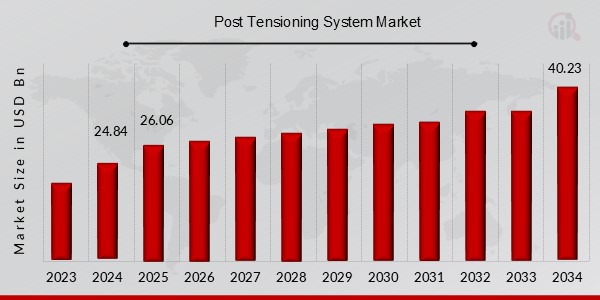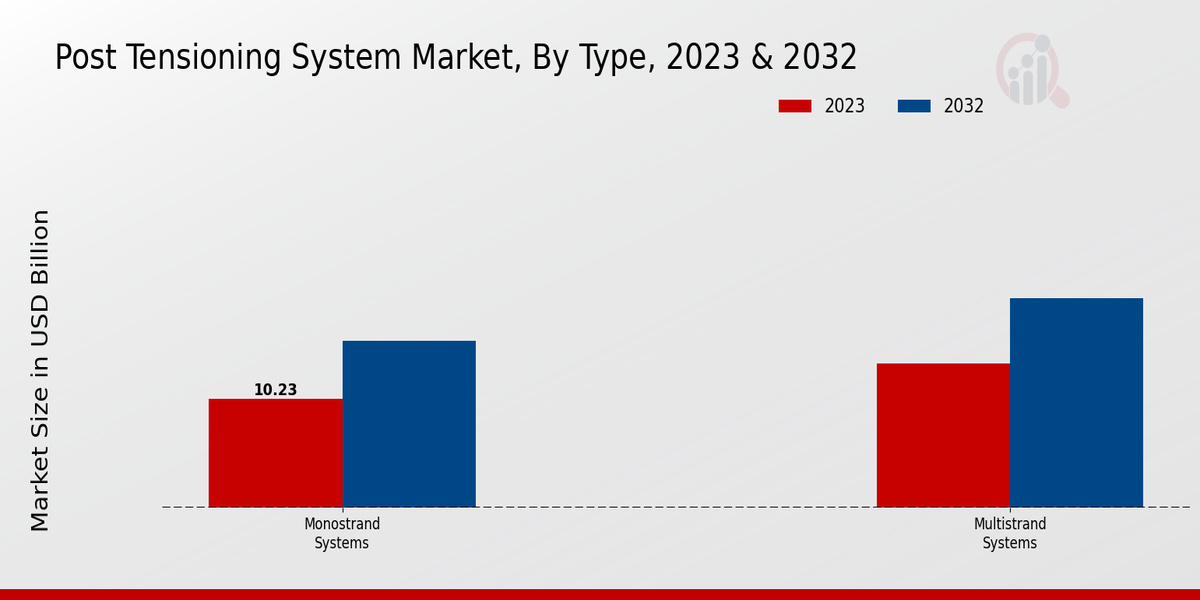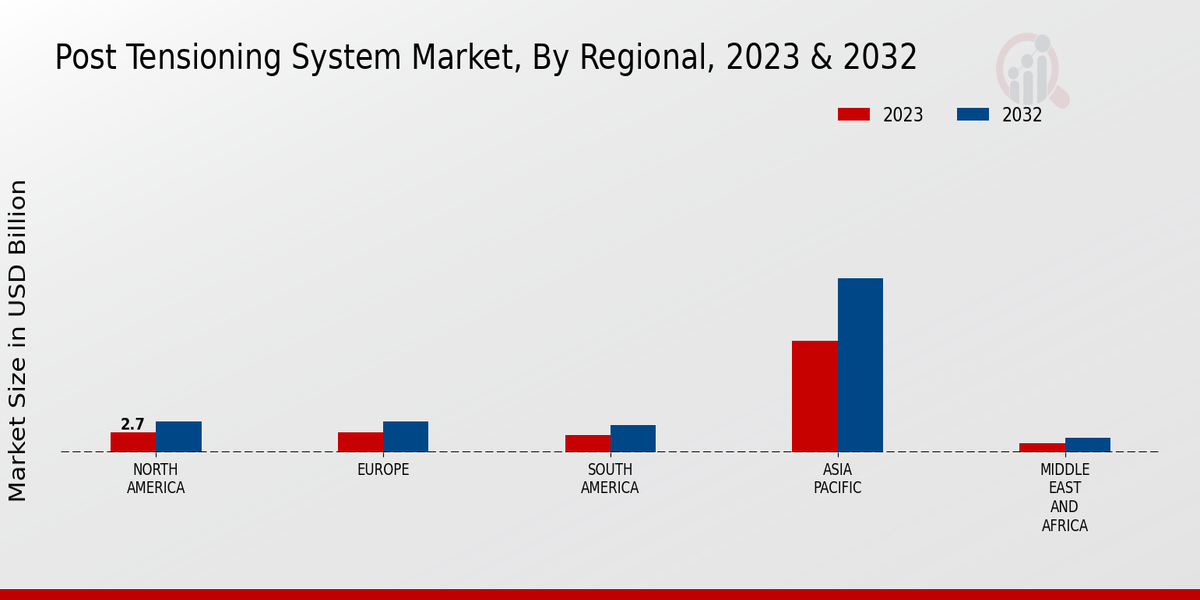Global Post Tensioning System Market Overview
The Post Tensioning System Market Size was estimated at 24.84 (USD Billion) in 2024. The Post Tensioning System Industry is expected to grow from 26.06 (USD Billion) in 2025 to 40.23 (USD Billion) by 2034. The Post Tensioning System Market CAGR (growth rate) is expected to be around 4.9% during the forecast period (2025 - 2034).
Key Post Tensioning System Market Trends Highlighted
Key market drivers include rising infrastructure development, growing demand for sustainable construction practices, and increasing adoption of post-tensioning systems in bridges, high-rise buildings, and other large-scale projects. Opportunities exist in expanding into emerging markets, developing innovative post-tensioning technologies, and offering integrated solutions that combine post-tensioning with other construction services. Recent trends include the use of fiber-reinforced polymers (FRP) in post-tensioning systems, the development of self-stressing systems, and the adoption of digital technologies for design and monitoring. By leveraging these trends and opportunities, market participants can position themselves for success in the global post-tensioning system market.

Source: Primary Research, Secondary Research, MRFR Database and Analyst Review
Post Tensioning System Market Drivers
Increasing Demand for High-Rise Buildings and Infrastructure
The modern tendency of extensive high-rise buildings and large infrastructure creation is boosting the demand for strong and reliable foundations. Thus, the development of the post-tensioning system market is powered by the current state of the engineering domain, as they provide high durability and stability for concrete buildings. It is particularly important for infrastructure objects, bridges, and, especially, high-raised buildings. As the global demographic and urbanization trends imply the population growth needs, the necessity for new and more complex high-rise buildings facilities is on the rise. It suggests that the post-tensioning systems market will experience stable growth.
Growing Adoption of Sustainable Construction Practices
The construction industry is more willing to adopt sustainable practices to reduce environmental harm and improve energy use. Post-tensioning systems are an important feature that contributes to the concept of sustainable construction by cutting down on the use of concrete and steel. The latter, which is very widely acquired in the construction business, increases the carbon footprint of any site, and getting rid of it is necessary. Moreover, the use of post-tensioning continuously improves the durability of the last, meaning that structures supported by the latter do not require frequent renewal and repair. Since sustainability is becoming an important factor in the construction business, the demand for post-tensioning systems will increase.
Advancements in Technology and Materials
The Post Tensioning System Market Industry is witnessing continuous advancements in technology and materials, leading to improved performance and cost-effectiveness of post-tensioning systems. Innovations in materials, such as the development of high-strength steel and fiber-reinforced polymers, have led to lighter and more durable post-tensioning systems. Moreover, advancements in design software and construction techniques have streamlined the installation process and enhanced the accuracy of post-tensioning systems. These technological advancements are expected to drive the adoption of post-tensioning systems in various construction applications.
Post Tensioning System Market Segment Insights
Post Tensioning System Market Type Insights
The Post Tensioning System Market is segmented by type into monostrand systems and multistrand systems. Monostrand systems use a single strand of high-strength steel, while multistrand systems use multiple strands. The growth of the market is attributed to the increasing demand for post-tensioning systems in the construction industry. Post-tensioning systems are used to reinforce concrete structures, making them more resistant to cracking and collapse. The monostrand systems segment is expected to hold a larger share of the Post Tensioning System Market in 2023 due to their lower cost and ease of installation.
However, the multistrand systems segment is expected to grow at a faster rate during the forecast period due to their higher load-bearing capacity. The key players in the Post Tensioning System Market include Dywidag, Freyssinet, and VSL. These companies offer a wide range of post-tensioning systems for different applications. The growth of the Post Tensioning System Market is expected to be driven by the increasing demand for new construction projects in developing countries. Post-tensioning systems are also being increasingly used in the renovation of existing structures, as they can help to extend the life of the structure.

Source: Primary Research, Secondary Research, MRFR Database and Analyst Review
Post Tensioning System Market Component Insights
The Component segment of the Post Tensioning System Market is anticipated to exhibit substantial growth in the coming years. Among the key components, Anchorages are projected to hold a significant market share, driven by their crucial role in securing tendons and transferring prestressing forces to concrete structures. Tendon Ducts are also expected to witness notable growth, owing to their function in protecting and guiding tendons during the tensioning process. Stressing Equipment, including jacks and pumps, is another vital component that contributes to the overall market growth.Grout, used for filling ducts and providing corrosion protection to tendons, is anticipated to further drive segment growth. These components collectively contribute to the efficiency and durability of post-tensioning systems, leading to increased demand across various construction projects.
Post Tensioning System Market Application Insights
The application segment plays a crucial role in shaping the Post Tensioning System Market. Building Construction held the largest market share in 2023, accounting for nearly 60% of the Post Tensioning System Market revenue. The growing demand for high-rise buildings, commercial complexes, and residential structures is driving the segment's growth. Infrastructure applications, such as bridges, tunnels, and highways, are also witnessing significant growth due to increasing government investments in infrastructure development. Industrial Construction, which includes warehouses, factories, and industrial facilities, is expected to offer lucrative growth opportunities for Post Tensioning System providers. The increasing demand for durable and resilient structures in the industrial sector is fueling the segment's growth.
Post Tensioning System Market Materials Insights
The materials segment of the Post Tensioning System Market is expected to grow at a significant rate in the coming years. Steel is the most commonly used material in post-tensioning systems due to its high strength and durability. Concrete is another commonly used material, but it is less strong than steel and is more susceptible to cracking. FRP (Fiber Reinforced Polymer) is a relatively new material that is being used in post-tensioning systems, and it offers a number of advantages over steel and concrete, including its high strength, lightweight, and corrosion resistance.The Post Tensioning System Market is expected to reach $22.56 billion in 2023 and $34.8 billion by 2032, growing at a CAGR of 4.94%. The growth of the market is attributed to the increasing demand for post-tensioning systems in the construction industry. Post-tensioning systems are used to strengthen concrete structures, making them more resistant to cracking and collapse. They are also used to create longer spans and lighter structures, which can save on construction costs. The materials segment of the Post Tensioning System Market is expected to grow at a CAGR of 5.2% from 2024 to 2032.The growth of the segment is attributed to the increasing demand for high-strength and durable materials in the construction industry. Steel is expected to remain the most commonly used material in post-tensioning systems, but FRP is expected to gain market share due to its advantages over steel and concrete.
Post Tensioning System Market Stress Level Insights
The Post Tensioning System Market is segmented by stress level into High Strength (>= 1,000 MPa) and Low Strength (= 500 MPa). The High Strength segment is expected to account for a larger share of the market in 2023, owing to its superior strength and durability. The demand for high strength post tensioning systems is growing rapidly due to the increasing construction of tall buildings and infrastructure projects. The growth of the market is attributed to the increasing demand for post tensioning systems in the construction industry, particularly in developing countries.Post tensioning systems are used to strengthen concrete structures, making them more resistant to cracking and collapse. They are also used to create longer spans and lighter structures, which can save on construction costs.
Post Tensioning System Market Regional Insights
The regional segmentation of the Post Tensioning System Market offers valuable insights into the geographical distribution of market growth and opportunities. North America, Europe, APAC, South America, and MEA represent key regional segments in this market. North America is projected to hold a significant share of the Post Tensioning System Market revenue, driven by the increasing adoption of sustainable construction practices and the growing demand for high-rise buildings. Europe follows closely, with a robust construction industry and a focus on energy-efficient building solutions.APAC is expected to witness substantial growth due to rapid urbanization and infrastructure development in countries like China, India, and Southeast Asia. South America and MEA are emerging markets with potential for growth as governments invest in infrastructure projects and promote modern construction techniques. These regional insights are crucial for businesses operating in the Post Tensioning System Market to tailor their strategies and capitalize on growth opportunities in specific geographies.

Source: Primary Research, Secondary Research, MRFR Database and Analyst Review
Post Tensioning System Market Key Players And Competitive Insights
Major players in the Post Tensioning System Market are investing significantly in research and development to enhance their product offerings and gain a competitive edge. Leading Post Tensioning System Market players are focusing on developing innovative solutions that meet the evolving demands of the construction industry. The Post Tensioning System Market industry is characterized by intense competition among established players as well as emerging entrants. Strategic partnerships and collaborations are becoming increasingly common as companies seek to expand their market reach and strengthen their competitive position. Furthermore, the Post Tensioning System Market landscape is expected to witness further consolidation in the coming years as larger players acquire smaller companies to expand their product portfolios and geographical presence.Dywidag-Systems International is a leading provider of post-tensioning systems and services. The company has a global presence, with operations in over 60 countries. Dywidag-Systems International offers a wide range of post-tensioning systems, including bonded and unbonded systems, as well as a variety of accessories and services. The company's products are used in a variety of applications, including bridges, buildings, and other structures. Dywidag-Systems International is committed to providing high-quality products and services, and the company has a strong reputation for reliability and innovation.VSL is another leading provider of post-tensioning systems and services. The company has a global presence, with operations in over 70 countries. VSL offers a wide range of post-tensioning systems, including bonded and unbonded systems, as well as a variety of accessories and services. The company's products are used in a variety of applications, including bridges, buildings, and other structures. VSL is committed to providing innovative solutions, and the company has developed a number of patented technologies that improve the performance and safety of post-tensioning systems.
Key Companies in the Post Tensioning System Market Include
- Mitsubishi Heavy Industries
- Heitec
- TCI
- China Railway Major Bridge Engineering Group
- Tensa
- Titan America
- Gerdau
- Mabey
- Jiangsu Zhongtian Technology
- Walters International
- Maccaferri
- Dywidag
- Freyssinet
- VSL
- BBR
Post Tensioning System Market Industry Developments
The post-tensioning system market is projected to grow significantly in the coming years. The increasing demand for high-rise buildings and infrastructure projects is driving the growth of the post-tensioning system market. Post-tensioning systems are used to strengthen concrete structures, making them more resistant to cracking and collapse. They are commonly used in bridges, parking garages, and stadiums. The Asia-Pacific region is expected to witness the highest growth in the post-tensioning system market due to the increasing construction activities in the region.Key developments in the post-tensioning system market include the introduction of new products and technologies. For instance, in 2023, DYWIDAG-Systems International (DSI) introduced a new post-tensioning system called the DYWIDAG Threadbar System. This system is designed to provide high strength and durability in concrete structures.
Post Tensioning System Market Segmentation Insights
-
Post Tensioning System Market Type Outlook
- Monostrand Systems
- Multistrand Systems
-
Post Tensioning System Market Component Outlook
- Anchorages
- Tendon Ducts
- Stressing Equipment
- Grout
-
Post Tensioning System Market Application Outlook
- Building Construction
- Infrastructure
- Industrial Construction
-
Post Tensioning System Market Materials Outlook
-
Post Tensioning System Market Stress Level Outlook
- High Strength (>= 1,000 MPa)
- Low Strength (= 500 MPa)
| Report Attribute/Metric |
Details |
| Market Size 2024 |
24.84 (USD Billion) |
| Market Size 2025 |
26.06 (USD Billion) |
| Market Size 2034 |
40.23 (USD Billion) |
| Compound Annual Growth Rate (CAGR) |
4.9% (2025 - 2034) |
| Report Coverage |
Revenue Forecast, Competitive Landscape, Growth Factors, and Trends |
| Base Year |
2024 |
| Market Forecast Period |
2025 - 2034 |
| Historical Data |
2020 - 2024 |
| Market Forecast Units |
USD Billion |
| Key Companies Profiled |
Mitsubishi Heavy Industries, Heitec, TCI, China Railway Major Bridge Engineering Group, Tensa, Titan America, Gerdau, Mabey, Jiangsu Zhongtian Technology, Walters International, Maccaferri, Dywidag, Freyssinet, VSL, BBR |
| Segments Covered |
Type, Component, Application, Materials, Stress Level, Regional |
| Key Market Opportunities |
Highrise Building Construction Infrastructure Development Sustainable Building Practices Prefabricated Construction Bridge Construction |
| Key Market Dynamics |
Increased infrastructure investment growth in commercial construction technological advancements, government regulations, and environmental concerns |
| Countries Covered |
North America, Europe, APAC, South America, MEA |
Frequently Asked Questions (FAQ) :
The Post Tensioning System Market was valued at 26.06 billion USD in 2025.
The Post Tensioning System Market is expected to reach 34.8 billion USD by 2034.
The Post Tensioning System Market is projected to grow at a CAGR of 4.9% from 2025 to 2034.
Asia-Pacific is expected to hold the largest market share in the Post Tensioning System Market during the forecast period.
Post Tensioning Systems are primarily used in the construction of bridges, high-rise buildings, and other structures that require high strength and durability.
Major competitors in the Post Tensioning System Market include Dywidag Systems International, VSL International, Freyssinet, PFEIFER, and DSI.
Key growth drivers of the Post Tensioning System Market include increasing demand for infrastructure development, rising construction activities, and growing awareness of the benefits of post tensioning systems.
Major challenges faced by the Post Tensioning System Market include fluctuating raw material prices, skilled labor shortages, and intense competition from alternative construction methods.
Key trends in the Post Tensioning System Market include the growing adoption of sustainable construction practices, the use of advanced technologies such as BIM, and the increasing demand for prefabricated post tensioning systems.
Government regulations related to construction safety and sustainability are expected to have a positive impact on the Post Tensioning System Market.
















